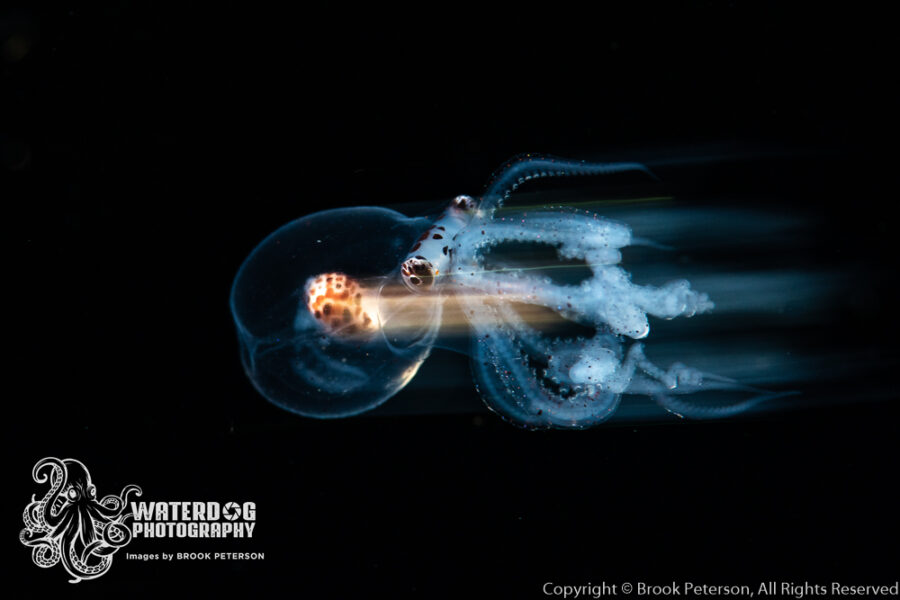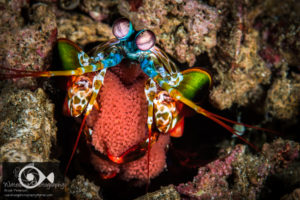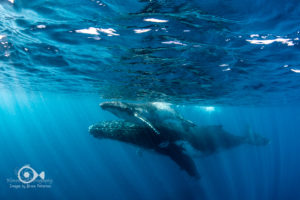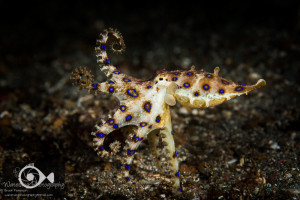Making photographs underwater can be a challenge for any scuba diver, and when you realize that the environment is always moving, capturing a clear image seems nearly impossible. Most of the time, we do our best to get the image we want by holding as still as we can and relying on our camera settings to “freeze” the action. But sometimes it is more fun and more creative to show the movement of the watery environment we are in.
Sports and wildlife photographers have been known to show motion in their images by following a fast moving subject with the lens and using a slow shutter speed to blur the background. This creates a sense of fast motion and is an effective technique. The subject is in sharp focus, and the background is blurred giving the photo a dynamic quality that is pleasing to the viewer.

There are several types of motion blur that you can try in underwater photography. In the image above, the bull kelp was being tossed around by the surge and I wanted to show that motion. Since the kelp was stationary, this would require me to move the camera to get the effect. I chose to turn the camera in a counterclockwise direction during the exposure. The camera settings were 1/13th, f/22, ISO 100. It was necessary to close down my aperture and set the ISO to a minimum because the kelp was in shallow, bright conditions.

You may want to show the movement of a fast swimming fish by panning through a shot. To do this, slow your shutter speed down to somewhere between 1/8s and 1/15s. Depending on the lighting conditions of the water you are in, you will need to adjust your aperture and ISO to compensate for the long exposure. Panning means that you are moving the camera with the subject. Your flash, by default, will fire at the beginning of the exposure, but the shutter remains open for a fraction of a second after the flash. This will have the effect of “freezing” the subject at the beginning of the exposure, and trailing it’s “ghost” or “shadow” behind it, giving a sense of movement. Be sure to move the camera in the same direction and a little faster than the subject is moving so the blur is behind and not in front or you will get an image like the one below.

SLR cameras and mirrorless cameras have a setting that will allow the flash to fire at the end of the exposure instead of the beginning. This is sometimes called “Rear Curtain Sync.” If you are holding your camera still, and the subject is moving fast, this setting is ideal. It is slightly more difficult because if your subject is moving during the shot, you cannot plan your composition as accurately. The subject will be “frozen” at the end of the exposure. However, the advantage of having the subject frozen at the end of the exposure is that it will trail the blurred shadow behind it instead of in front of it.

You can also use front curtain sync and get the blur in the right direction if you pan across the subject so that the end of the exposure happens behind the subject.
Sometimes, as a photographer, you might be looking to do nothing more than have a creative effect in your photography. Spin shots around stationary subjects are a great place to practice this technique and sometimes yield interesting results. Keep in mind that you should slow down the shutter speed to anywhere between 1/8 and 1/15 second. Any faster and you may not get the illusion of movement, and any slower and you may not be able to control the light. You don’t need to move your camera super fast. Think of turning the camera about same speed you might turn the wheel of your car. Lock down your strobes tightly and use front curtain sync.
Panning and Spins are a great way to change up your portfolio and have fun with your camera underwater. Don’t be afraid to experiment and enjoy the ride!
Join me for a workshop! Travel to a great destination where you will have exclusive coaching on your underwater photography. Meet new people, network, try new techniques, and learn with the pros! Click on Travel and Workshops for more information.
Subscribe now!
As always, if you enjoy my images please visit my website, waterdogphotography.com, or give me a like on Facebook at Waterdog Photography Brook Peterson. Don’t forget to follow me here at waterdogphotographyblog and please feel free to share on Facebook or other social media.
My photographs are taken with a Nikon D850 in Sea and Sea Housing using two YS-D2J Strobes.
All images and content are copyright protected by Brook Peterson and may only be used with written permission. Please do not copy or print them. To discuss terms for using these images, please contact me.
© Brook Peterson 2020






